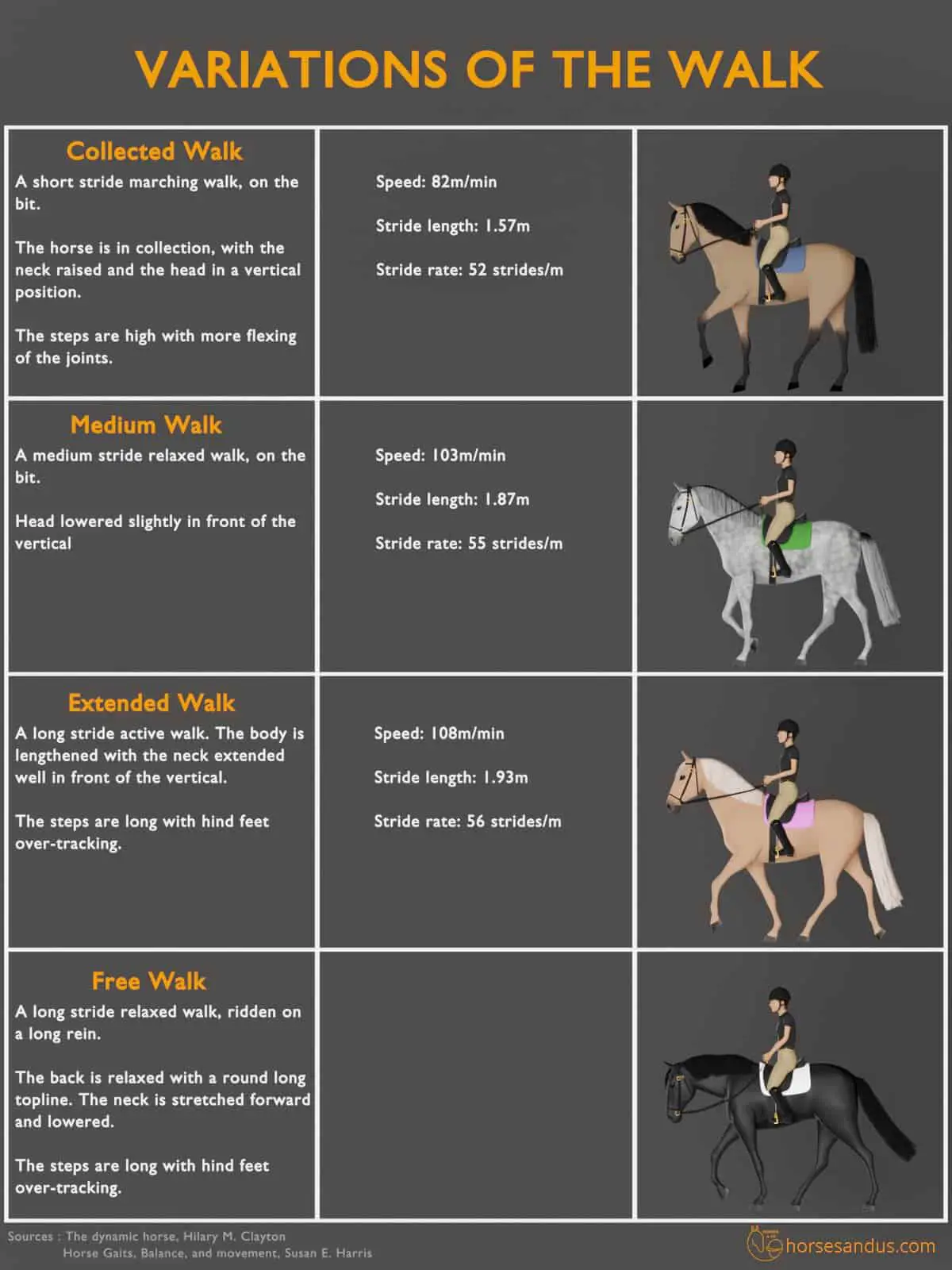You’ve always been intrigued by the grace and power of horses. There’s just something about the way they move that captivates you. And now that you’ve taken up horseback riding, you’re eager to gain a deeper understanding of the different gaits these majestic creatures possess. In this article, we’ll explore the world of horseback riding and take a closer look at the various gaits that horses can perform.
From the rhythmic beat of a walk to the exhilarating speed of a gallop, horses have an incredible range of movement. Whether you’re a beginner or an experienced rider, understanding the different gaits is essential for a successful riding experience. We’ll break down each gait and examine its purpose, intricacies, and how it feels when you’re in the saddle. So saddle up and get ready to embark on a journey through the world of horseback riding. By the end of this article, you’ll have a newfound appreciation for the incredible athletic ability of these magnificent creatures.
Understanding the Different Gaits in Horseback Riding
Horseback riding is not only a popular recreational activity, but also a competitive sport that requires skill and understanding of the horse’s movements. One key aspect of riding is the ability to distinguish and ride the different gaits of a horse. Gaits are the various ways a horse moves its legs and body while in motion. Each gait has unique characteristics and requires different techniques from the rider. In this article, we will explore the basics of horse gaits, the factors that affect them, how to correct gait problems, the benefits and uses of different gaits, and various training exercises to improve gaits. So, let’s dive in and expand our knowledge about the different gaits in horseback riding!
The Basics of Horse Gaits
To grasp the concept of horse gaits, it’s important to understand that horses have both natural and artificial gaits. Natural gaits are those that a horse naturally performs without any training, while artificial gaits are those that are developed through specific training techniques. There are four main natural gaits: the walk, trot, canter, and gallop.

The Importance of Understanding Horse Gaits
Understanding horse gaits is crucial for several reasons. First and foremost, it allows riders to communicate effectively with their horses. By being aware of which gait a horse is in and understanding its characteristics, riders can adjust their aids and body position accordingly. Additionally, different gaits are used for various purposes and disciplines, so riders need to be able to choose the appropriate gait for the situation. Finally, having a good understanding of horse gaits enables riders to identify and correct any issues that may arise, such as gait irregularities or imbalances.
The Walk
The walk is the slowest natural gait of a horse, but it is also the most efficient and rhythmic. The walk is a four-beat gait, meaning that each foot hits the ground individually in a distinct sequence. The horse moves its legs in a diagonal pattern, meaning that when the left hind leg moves forward, the right front leg also moves forward. This results in a smooth and steady movement.
Characteristics of the Walk
The walk is characterized by a clear four-beat rhythm, where each hoof individually touches the ground. The horse’s head and neck should be relaxed and extended forward, following the natural motion of the walk. The back should be supple and relaxed, allowing the hind legs to step forward freely. The walk is the gait most commonly used for warm-ups, cooling down, and trail riding due to its comfortable nature.
How to Ride the Walk
To ride the walk, sit deeply in the saddle and relax your body. Your legs should hang naturally and your hands should be steady but not restrictive. Use your seat and legs to encourage forward movement, while maintaining a consistent rein contact. It’s important to keep a steady rhythm and not rush or slow down the horse’s walk. Remember to maintain a balanced position and allow the horse to move freely.
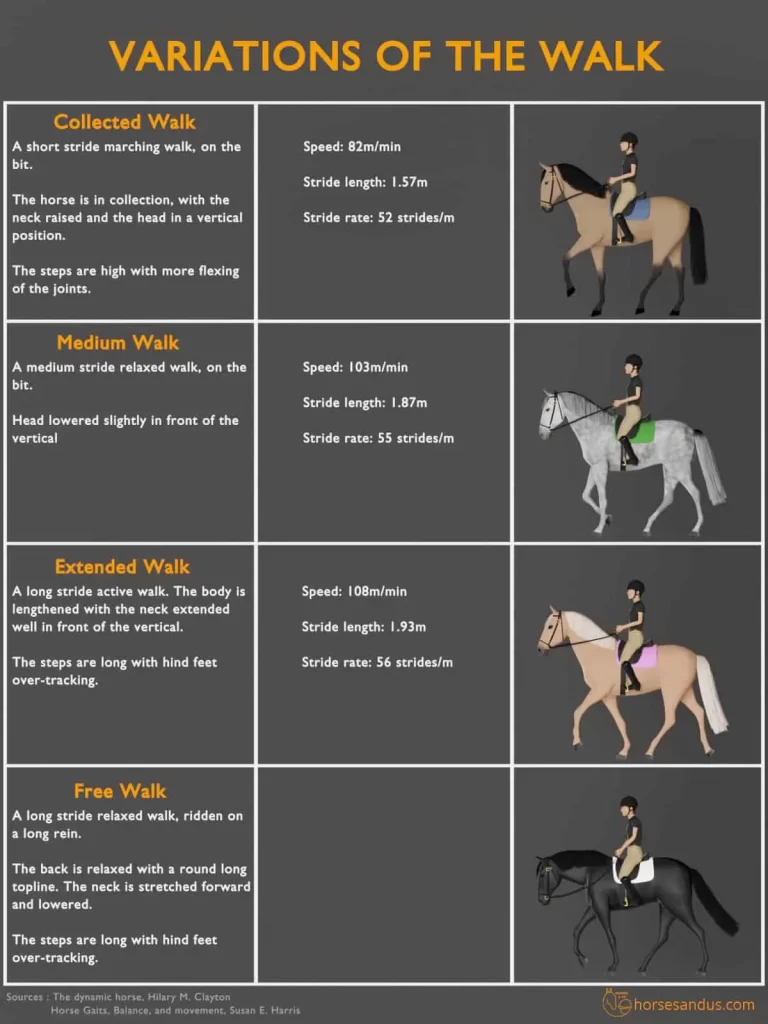
The Trot
The trot is a two-beat gait that is faster than the walk but slower than the canter. It is characterized by a diagonal pair of legs moving together. When the left front leg moves forward, the right hind leg moves forward at the same time, and vice versa. The trot can be ridden in two forms: the rising (posting) trot, where the rider rises and sits in harmony with the horse’s motion, and the sitting trot, where the rider remains seated throughout the trotting motion.
Characteristics of the Trot
The trot is a bouncy and energetic gait, which requires the horse to engage its abdominal muscles for a suspended movement. The horse’s body should be balanced and in a level position, with its head and neck naturally extended forward. The strides of the trot should be even and regular, without any hesitation or irregularities. The trot is commonly used in various disciplines, such as dressage, jumping, and endurance riding.
How to Ride the Trot
When riding the rising trot, the rider should rise and sit in rhythm with the horse’s movement. This allows the rider to maintain balance and stay in sync with the horse’s motion. In the sitting trot, the rider needs to relax their hips and lower back, allowing them to move freely without inhibiting the horse’s movement. The rider’s hands should be soft and elastic, allowing for consistent contact.
The Canter
The canter is a three-beat gait that is faster than the trot. It is considered a more elegant and collected gait than the trot and is often used in equestrian sports such as dressage and show jumping. The canter involves a sequence of footfalls: the outside hind leg, followed by the inside hind leg and the outside front leg, and finally the inside front leg.
Characteristics of the Canter
The canter is a smooth and flowing gait, characterized by a rocking motion. The horse’s inside hind leg serves as a pivot point for each stride. The horse’s head and neck should be slightly arched, with the horse’s weight evenly distributed between the front and hindquarters. The canter has three distinct beats: the outside hind leg strikes the ground first, followed by a moment of suspension when all four feet are off the ground, and finally, the inside hind and outside front legs land together.
How to Ride the Canter
To ride the canter, the rider needs to sit deep in the saddle and follow the horse’s motion. The rider’s hands should be soft and supportive, maintaining a consistent and even contact. The rider’s legs should be relaxed and positioned slightly behind the girth, with the inside leg applying gentle pressure to encourage the canter. The rider should avoid leaning forward or backward, instead maintaining an upright and balanced position.
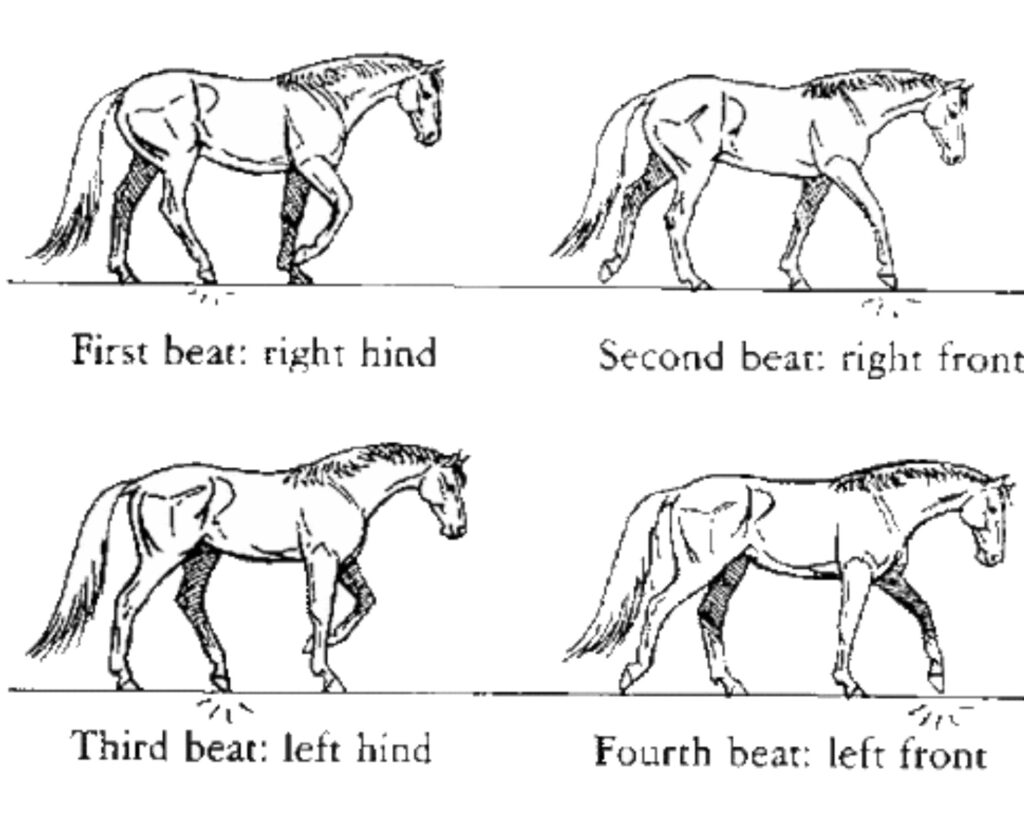
The Gallop
The gallop is the fastest natural gait of a horse and is often associated with speed and power. It is a four-beat gait, similar to the walk, but much faster. During the gallop, the horse’s body is fully extended, with all four legs off the ground at certain points. This gait is commonly seen in horse racing, cross-country riding, and other fast-paced equestrian disciplines.
Characteristics of the Gallop
The gallop is characterized by a series of bounds, with each foot striking the ground individually. Unlike other gaits, the gallop involves a moment of suspension, where all four feet are off the ground. The horse’s body is fully extended and elongated during the gallop, allowing for maximum speed and propulsion. The gallop has a slightly uneven rhythm due to the individual footfalls.
How to Ride the Gallop
Riding the gallop requires a secure and balanced seat, as this gait is known for its speed and intensity. The rider should maintain a light and soft contact on the reins, allowing the horse to stretch its neck and use its head and neck for balance. The rider should slightly lean forward, while keeping the upper body straight and balanced. It’s important to maintain a steady rhythm and avoid any sudden movements or pulls on the reins.
Other Gaits in Horseback Riding
In addition to the four natural gaits, there are several other gaits that are specific to certain horse breeds or disciplines. These gaits include the foxtrot, the rack, the running walk, the Paso Fino, and the Tolt. These gaits have their own unique characteristics and are often showcased in specific events or competitions.
The Foxtrot
The foxtrot is a gait that is most commonly associated with Missouri Foxtrotter horses. It is a four-beat gait that is smooth and comfortable for riders. The foxtrot involves a broken diagonal movement, where the front foot strikes the ground first, then the opposite hind foot, and finally the other front and hind feet. This gait allows for a smooth gliding motion, making it suitable for long trail rides.
The Rack
The rack is a distinct gait performed by Icelandic horses. It is a four-beat lateral gait where each foot touches the ground individually in rapid succession. The rack is a fast and smooth gait, often used for covering long distances at a quick pace. Icelandic horses are particularly known for their ability to perform the rack naturally and effortlessly.
The Running Walk
The running walk is a gait that is specific to certain gaited horse breeds, such as the Tennessee Walking Horse. It is a four-beat gait that is faster than a walk but slower than a canter. The running walk is characterized by a distinct head nod and a sliding or gliding motion. This gait is highly prized in the show ring for its smoothness and elegance.
The Paso Fino
The Paso Fino is a gait that originates from the Paso Fino horse breed, which is native to Puerto Rico. It is a four-beat gait that is known for its unique rhythm and cadence. The Paso Fino gait is smooth, steady, and highly collected. This gait is often showcased in Paso Fino competitions and is highly valued for its exceptional balance and precision.
The Tolt
The Tolt is a gait specific to Icelandic horses and is an important part of their heritage. It is a four-beat gait that is smooth and comfortable for both horse and rider. The Tolt is similar to the running walk but has a distinct head nod and a more upright posture. Icelandic horses are highly prized for their ability to perform the Tolt naturally and effortlessly.
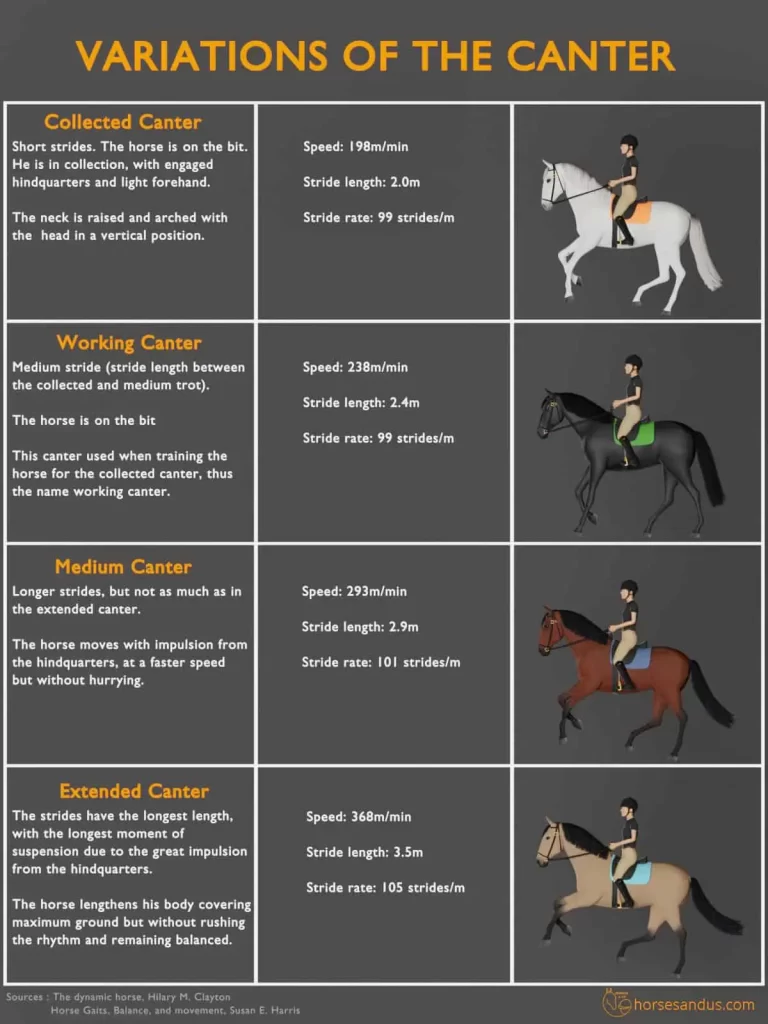
Factors Affecting Horse Gaits
Several factors can affect a horse’s gaits, including conformation, muscle development, breed characteristics, tack and equipment, physical fitness and health, and training and conditioning. Let’s explore these factors in more detail.
Conformation
Horse conformation refers to the overall structure and physical characteristics of a horse. A horse’s conformation can affect its ability to perform certain gaits. For example, a horse with a longer back and well-angled hindquarters will likely have more fluid and extended gaits, while a horse with a shorter back and less angulation may have more collected gaits.
Muscle Development
Muscle development plays a crucial role in a horse’s ability to perform its gaits correctly. The muscles in the horse’s hindquarters and back are particularly important for propulsion and engagement. Lack of muscle development or imbalance in muscle strength can cause irregularities or difficulties in gaits. Proper training and conditioning exercises can help build and strengthen the necessary muscles.
Breed Characteristics
Different horse breeds have specific characteristics and traits that can affect their gaits. Certain breeds, such as gaited horse breeds, are naturally predisposed to perform certain gaits, while others may have a natural inclination towards specific movements. Breed characteristics can influence the horse’s natural movement and make it more suitable for certain disciplines or activities.
Tack and Equipment
The type of tack and equipment used can also have an impact on a horse’s gaits. Ill-fitting saddles or improperly adjusted bridles can cause discomfort, pain, and restricted movement. It’s crucial to ensure that the horse’s tack and equipment fit properly and allow for freedom of movement. The use of appropriate bits, saddle pads, and other equipment can also influence the horse’s balance and gait quality.
Physical Fitness and Health
A horse’s physical fitness and overall health play a significant role in its ability to perform its gaits correctly and comfortably. Regular exercise, proper nutrition, and routine veterinary care are essential for maintaining a horse’s physical well-being. Any underlying health issues or injuries can affect the horse’s movement and should be addressed promptly.
Training and Conditioning
Proper training and conditioning are essential for developing and refining a horse’s gaits. A well-trained horse understands the rider’s cues and can perform the required movements with ease and precision. Training techniques, such as lunging, long lining, and under-saddle exercises, can help improve balance, strength, and suppleness, leading to better gaits.
Correcting Gait Problems
Gait problems can occur for various reasons, including conformational issues, muscle imbalances, poor training techniques, or discomfort or pain. Diagnosing and correcting gait problems is crucial for both the horse’s well-being and the rider’s safety. Here we will discuss common gait problems, their causes, and corrective exercises and techniques.
Diagnosing Gait Issues
Identifying and diagnosing gait issues can be a complex task that requires the expertise of a qualified equine professional. Gait irregularities can manifest as stiffness, unevenness, resistance, or resistance to perform a specific gait. A thorough examination by a veterinarian, trainer, or equine bodyworker can help pinpoint the underlying cause of the gait problem.
Common Gait Problems
Gait problems can occur in any gait and can vary in severity. Some common gait problems include:
-
Pacing: Pacing is an uneven lateral gait where the legs on one side of the horse move together. It is commonly seen in Standardbred racehorses but is considered undesirable in most other disciplines.
-
Crossfiring: Crossfiring is a phenomenon where a horse’s hind leg strikes the opposite foreleg during a particular gait. It is often seen in horses with poor coordination or lack of balance.
-
Winging In or Out: Winging in or out refers to a horse that paddles or swings its legs out to the side while in motion. This can be caused by conformational issues or muscle imbalances.
Causes of Gait Problems
Gait problems can have various causes, including conformational issues, muscle imbalances, pain or discomfort, or incorrect training techniques. Identifying the root cause of the gait problem is essential for implementing the appropriate corrective measures.
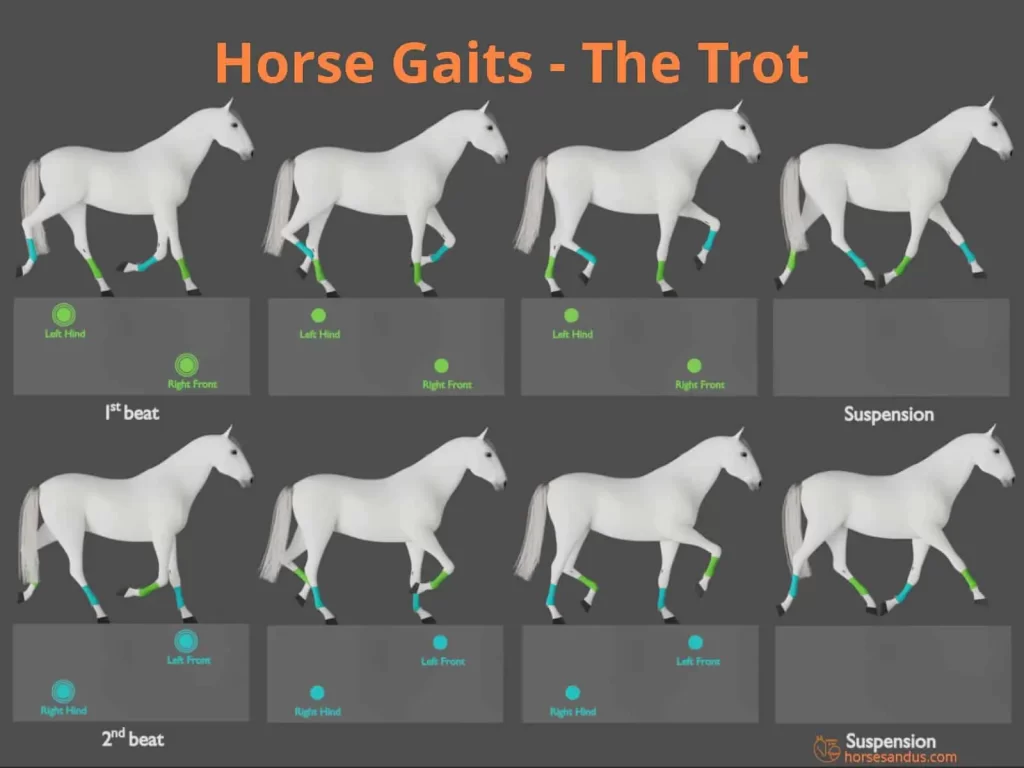
Corrective Exercises and Techniques
Correcting gait problems often requires a multi-faceted approach that addresses the underlying cause while focusing on improving the horse’s balance, strength, and coordination. Here are some common corrective exercises and techniques that can help improve gait quality:
Strengthening Exercises
-
Hill Work: Incorporating hill work into a horse’s training regimen can help strengthen the hindquarters, improve balance, and develop more powerful and controlled gaits.
-
Pole Exercises: Ground poles can be used to encourage the horse to engage its hind end and lift its back, resulting in more balanced and rhythmic gaits. Exercises such as raised cavaletti or trot poles can help improve muscle coordination and flexibility.
Flexibility Exercises
-
Stretching and Suppling: Stretching exercises, such as carrot stretches or lateral flexion exercises, can help improve a horse’s suppleness and flexibility. This allows the horse to move in a more balanced and fluid manner.
-
Massage and Bodywork: Regular bodywork sessions, such as massage or chiropractic adjustments, can help alleviate muscle tension, improve joint mobility, and enhance the horse’s overall movement.
Training Techniques
-
Transitions: Incorporating frequent transitions within and between gaits can help improve balance, engagement, and responsiveness. Focus on smooth and seamless transitions to encourage the horse to shift its weight and engage the appropriate muscles.
-
Lateral Work: Lateral exercises, such as leg-yields or shoulder-in, can help improve the horse’s suppleness, balance, and coordination. These exercises encourage the horse to engage its hindquarters and step under its body.
Benefits and Uses of Different Gaits
Understanding the benefits and uses of different gaits can help riders select the appropriate gait for a specific discipline, activity, or training goal. Here are some key benefits associated with different gaits:
Versatility in Riding Styles and Disciplines
Different gaits offer riders versatility in various riding styles and disciplines. From the calm and soothing walk for trail riding to the powerful and collected canter for dressage, each gait has its own purpose and application.
The Importance of a Smooth Ride
A smooth ride is essential for both the horse and the rider. Certain gaits, such as the running walk or the rack, offer incredibly smooth and comfortable rides, making them highly desirable for long trail rides or endurance competitions.
Engaging Different Muscle Groups
Each gait requires the horse to engage specific muscle groups. By incorporating a variety of gaits into a horse’s training routine, riders can target and develop different muscle sets, leading to a more well-rounded and balanced horse.
Developing Balance and Coordination
Different gaits challenge a horse’s balance and coordination in unique ways. By working with horses in various gaits, riders can help them develop better proprioception, spatial awareness, and overall body control.
Enhancing Communication and Connection with the Horse
Riding different gaits requires riders to adjust their aids and body position accordingly. By fine-tuning their communication skills, riders can develop a deeper connection and understanding with their horses.
Gait Transitions and Transitions within Gaits
Transitions between gaits and transitions within gaits are crucial elements of horse training. By mastering these transitions, riders can further improve their horse’s balance, responsiveness, and overall movement.
Importance of Smooth Transitions
Smooth transitions are essential for maintaining a horse’s balance, rhythm, and engagement. Abrupt or poorly executed transitions can cause tension, loss of balance, or confusion. Smooth transitions allow the horse to carry its weight correctly and fluidly move between different gaits.
Techniques for Smooth Transitions
To achieve smooth transitions between gaits, riders need to focus on their balance, timing, and communication with the horse. Applying clear and consistent aids, supporting the horse’s balance with proper body position, and using half-halts can help achieve seamless transitions.
Transitions within Gaits
Transitions within gaits, such as lengthening or shortening strides, are essential for developing adjustability, collection, and extension. These transitions give riders more control over the horse’s speed, impulsion, and balance.
Maintaining Rhythm and Tempo
When executing transitions within gaits, it’s important to maintain the horse’s rhythm and tempo. Adjusting the stride length should not compromise the overall quality or regularity of the gait. Focusing on the horse’s balance and using appropriate aids can help maintain the desired rhythm.
Adjusting the Frame and Collection
Transitions within gaits also allow riders to work on adjusting the horse’s frame and collection. By asking the horse to collect or lengthen its frame, riders can develop more engagement, lift, and balance.
Training Exercises to Improve Gaits
Various training exercises can be incorporated into a horse’s training program to improve its gaits. These exercises focus on developing strength, balance, suppleness, and responsiveness. Here are some examples:
Walk-Trot Transitions
Practicing walk-trot transitions helps develop the horse’s responsiveness and adjustability. Begin with clear and consistent aids, and gradually ask the horse to transition smoothly between the walk and trot. Focus on maintaining a balanced and rhythmical stride in each gait.
Trot-Canter Transitions
Trot-canter transitions are essential for developing the horse’s ability to engage its hind end and lift its back. Start with clear upward transitions from the trot to the canter, asking the horse to step forward into a balanced and active canter. Practice downward transitions from canter to trot, focusing on maintaining the horse’s balance and self-carriage.
Canter-Gallop Transitions
Canter-gallop transitions are useful for improving the horse’s ability to transition smoothly from a controlled and collected canter to a more extended and powerful gallop. Start with clear and balanced transitions, gradually asking the horse to increase its speed and engagement.
Extension and Collection
Developing both extended and collected gaits is crucial for a well-rounded and versatile horse. Extension exercises focus on increasing stride length and power, while collection exercises develop engagement, balance, and self-carriage.
Developing Extended Gaits
To develop extended gaits, riders can incorporate lengthening exercises within each gait. Begin with clear and consistent aids, allowing the horse to gradually lengthen its stride while maintaining balance and rhythm. Focus on encouraging the horse to step forward with power and extension.
Achieving Collected Gaits
Achieving collected gaits requires riders to ask the horse to compress its frame, engaging the hindquarters and lifting the back. Practicing lateral exercises, transitions within gaits, and balancing exercises can help develop the horse’s collection and self-carriage.
Cavaletti Exercises
Cavaletti exercises involve working the horse over raised poles or small jumps. These exercises can help improve coordination, adjustability, and balance. Various cavaletti exercises can be tailored to each gait, focusing on specific aspects of the horse’s movement.
Walk and Trot Cavaletti Exercises
In the walk, riding over raised poles can encourage the horse to step under its body, engage its hindquarters, and develop better suspension. In the trot, cavaletti exercises can help develop better impulsion, rhythm, and adjustability.
Canter and Gallop Cavaletti Exercises
In the canter and gallop, cavaletti exercises can help improve adjustability, balance, and coordination. These exercises encourage the horse to develop a more powerful and collected canter or gallop stride, while also improving its overall jumping technique.
Horse Gaits in Different Riding Disciplines
Different riding disciplines have their own specific requirements and expectations when it comes to horse gaits. Here are some examples of how different disciplines utilize horse gaits:
Dressage
Dressage focuses on developing a horse’s athleticism, balance, and precision. Correct and expressive gaits are essential for success in dressage. Horses are expected to perform all gaits with fluidity, regularity, and engagement.
Western Pleasure
In Western Pleasure, horses are judged on their movement, manners, and overall demeanor. Horses should demonstrate a slow, comfortable, and relaxed jog trot, a smooth and collected lope, and a natural and balanced walk.
Hunter/Jumper
In Hunter/Jumper competitions, horses are required to have a balanced and rhythmic canter, displaying good impulsion, scope, and control. Hunters should have a comfortable and flowing canter, while jumpers should have a more adjustable and powerful canter for jumping.
Endurance Riding
Endurance riding tests a horse’s stamina, fitness, and ability to cover long distances at various speeds. Horses need to have efficient and comfortable gaits to ensure they can maintain their exertion over the entire course.
Trail Riding
In trail riding, the focus is on the horse’s ability to navigate a variety of terrains and obstacles. Horses should have a comfortable walk, an adjustable trot, and a sensible canter to provide a safe and enjoyable ride.
Reining
Reining is a Western riding discipline that focuses on precise and controlled maneuvers. Horses must have good responsiveness, balance, and control in all gaits, with particular emphasis on the spin, stop, and rollback.
Vaulting
Vaulting is a discipline that involves performing gymnastic and dance routines on a moving horse. The horse’s gaits need to be steady, rhythmic, and comfortable to provide a stable platform for the vaulters.
Recognizing and Appreciating Quality Gaits
Recognizing and appreciating quality gaits is essential for riders, trainers, and judges. Understanding the ideal standard for each gait can help identify horses with excellent movement and potential. Here are some factors to consider when assessing the quality of a horse’s gaits:
Understanding the Standard for Each Gait
Each gait has its own standard or ideal form, which riders and judges use as a reference. Familiarize yourself with the standard for each gait to recognize and appreciate the qualities that make a gait exceptional.
Recognizing Fluidity and Regularity
Fluidity and regularity are key indicators of quality gaits. A horse’s movement should be smooth, flowing, and consistent throughout each gait. Regular footfalls and even tempo contribute to a well-balanced and harmonious appearance.
Balance and Impulsion
Quality gaits should demonstrate good balance and impulsion. A balanced gait shows equal weight distribution between the front and hindquarters, while impulsion refers to the horse’s desire and ability to move forward with energy and power.
Collection and Extension
Quality gaits should display the horse’s ability to collect and extend its frame and stride. Collection requires engagement and compression, resulting in increased balance and self-carriage. Extension involves elongating the stride and using the body to cover more ground.
Natural and Correct Movement
Natural and correct movement is essential for quality gaits. Horses should move freely and comfortably, without any signs of stiffness, resistance, or tension. Correct movement promotes efficiency, soundness, and longevity in the horse’s performance.
Judge’s Perspective on Gaits
Judges play a critical role in evaluating the quality of a horse’s gaits in competitions. Understanding the judge’s perspective can help riders present their horse’s gaits effectively. Judges evaluate factors such as rhythm, impulsion, balance, collection, extension, and overall harmony with the rider.
Horse Gaits and Rider Experience Level
The suitability of different gaits for riders depends on their experience level, skill, and training. Novice riders may find simpler, steady gaits, such as the walk and trot, more manageable and comfortable. As riders gain confidence and skill, they can progress to more challenging gaits, such as the canter and gallop.
Suitability of Gaits for Beginners
For beginners, the walk is often the most comfortable and safe gait to start with. The walk allows riders to gain confidence, develop balance, and focus on their position and aids. The trot can be more challenging due to its bounciness, but with practice, beginners can become proficient in riding this gait as well.
Importance of Rider’s Balance and Skill
A rider’s balance and skill play a crucial role in effectively riding and transitioning between different gaits. As riders gain experience and improve their balance, they will be better equipped to handle the challenges of faster and more intense gaits.
Developing a Feel for Different Gaits
Developing a feel for different gaits requires time, practice, and a keen sense of body awareness. Regular riding and exposure to various gaits allow riders to develop their senses and become more attuned to the horse’s movements, rhythm, and cadence.
Progressively Advancing in Gaits
Advancing in gaits should be done progressively and at a pace that is comfortable and safe for both the rider and the horse. Riders should work with a knowledgeable instructor or trainer who can help them gradually transition to more advanced gaits as their skills and confidence grow.
Conclusion
Understanding the different gaits in horseback riding is essential for riders of all levels. By familiarizing ourselves with the characteristics and techniques associated with each gait, we can better communicate with our horses, choose suitable gaits for specific activities or disciplines, and identify and address any gait irregularities or problems. By incorporating proper training exercises, mastering gait transitions, and appreciating quality gaits, we can develop a deeper connection and achieve harmony with our equine partners. So, let’s continue expanding our knowledge and skill in the wonderful world of horse gaits!
